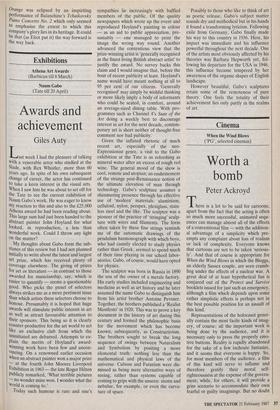Exhibitions
Athena Art Awards (Barbican till 8 March) Naum Gabo (Tate till 20 April)
Awards and achievement
Giles Auty
Last week I had the pleasure of talking with a venerable actor who studied at the Slade, with Rex Whistler, more than 60 Years ago. In spite of his own subsequent change of career, the actor has continued to take a keen interest in the visual arts. When I saw him he was about to set off for the Tate to see the current exhibition of Naum Gabo's work. He was eager to know my reaction to this and also to the £25,000 Athena award he had been reading about. This large sum had just been handed to the abstract painter John Hoyland for what looked, in reproduction, a less than wonderful work. Could I throw any light on the matter?
My thoughts about Gabo form the sub- stance of this review but I had not planned initially to write about the latest and largest art prize, which has received plenty of coverage elsewhere. The giving of prizes for art or literature — in contrast to those awarded for musicianship, say, which is easier to quantify — seems a questionable good. Who picks the panel of selectors always strikes me as a more pertinent issue than which artists these selectors choose to honour. Presumably it is hoped that huge awards will stimulate public interest in art as well as attract favourable attention to their sponsors. This being so it is clearly co. unter-productive for the art world to act like an exclusive club from which the uninitiated are debarred. Attempts to ex- plain the merits of Hoyland's award- winning work have been few and uncon- vincing. On a renowned earlier occasion when an abstract painter won a major prize — at the fourth John Moores Liverpool Exhibition in 1963 — the late Roger Hilton Publicly remarked, 'What terrible pictures no wonder mine won. I wonder what the world is coming to.' Today such humour is rare and one's sympathies lie increasingly with baffled members of the public. Of the quality newspapers which wrote up the event and reproduced Hoyland's painting in colour — as an aid to public appreciation, pre- sumably — one managed to print the image the wrong way round. Another advanced the contentious view that the prize-winning artist is 'generally recognised as the finest living British abstract artist' to justify the award. No survey backs this claim and I would imagine that, before the bout of recent publicity at least. Hoyland's name would have meant nothing at all to 95 per cent of our citizens. 'Generally recognised' may simply be wishful thinking or more likely imply a body of informant's who could be seated, in comfort, around an average-sized dining table. With pro- grammes such as Channel 4's State of the Art doing a weekly best to discourage interest in art for the next decade, contem- porary art is short neither of thought-free comment nor bad publicity.
Given the inflated rhetoric of much recent art, especially of the neo- Expressionist genre, a visit to the Gabo exhibition at the Tate is as refreshing as mineral water after an excess of rough red wine. The general mood of the show is cool, remote and utopian; an enshrinement of the strange post-Renaissance notion of the ultimate elevation of man through technology. Gabo's sculpture assumes a shimmering presence through his effective use of 'modern' materials: aluminium, celluloid, nylon, perspex, plexiglass, stain- less steel and the like. The sculptor was a pioneer of the practice of 'stringing' sculp- ture with wires and filaments. The form often taken by these fine strings reminds me of the automatic drawings of the pendulum harmonograph with which boys, who had cannily elected to study physics rather than Greek, seemed to spend much of their time playing in our school labor- atories. Gabo, of course, would have opted for physics.
The sculptor was born in Russia in 1890 the son of the owner of a metals factory. His early studies included engineering and medicine as well as art history and he later assumed the name Gabo to distinguish him from his artist brother Antoine Pevsner. Together, the brothers published a 'Realist Manifesto' in 1920. This was to prove a key document in the history of art during this century and formed the philosophic basis for the movement which has become known, subsequently, as Constructivism. The brothers sought to break the long sequence of swings between Naturalism and Symbolism by positing a more elemental truth: nothing less than the mathematical and physical laws of the universe. Cubism and Futurism were dis- missed as being mere alternative ways of seeing, rather than systems capable of coming to grips with the unseen: atoms and nebulae, for example, or even the curva- ture of space. Possibly to those who like to think of art as poetic release, Gabo's subject matter sounds dry and methodical but in his hands it found a transforming lyricism. Following exile from Germany, Gabo finally made his way to this country in 1936. Here, his impact was immediate and his influence powerful throughout the next decade. One of the artists most obviously affected by his theories was Barbara Hepworth yet, fol- lowing his departure for the USA in 1946, this influence became tempered by her awareness of the organic shapes of English landscape.
However beautiful, Gabo's sculptures retain some of the remoteness of pure theory. One feels the totality of their achievement lies only partly in the realms of art.


















































 Previous page
Previous page